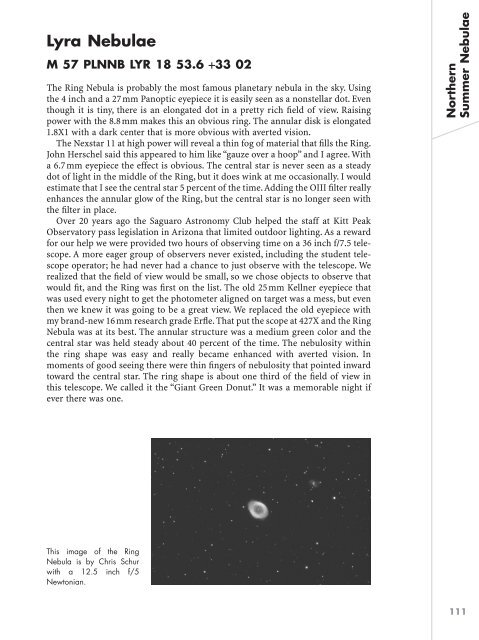Nebulae and How to Observe Them
Nebulae and How to Observe Them
Nebulae and How to Observe Them
You also want an ePaper? Increase the reach of your titles
YUMPU automatically turns print PDFs into web optimized ePapers that Google loves.
Lyra <strong>Nebulae</strong><br />
M 57 PLNNB LYR 18 53.6 +33 02<br />
The Ring Nebula is probably the most famous planetary nebula in the sky. Using<br />
the 4 inch <strong>and</strong> a 27mm Panoptic eyepiece it is easily seen as a nonstellar dot. Even<br />
though it is tiny, there is an elongated dot in a pretty rich field of view. Raising<br />
power with the 8.8mm makes this an obvious ring. The annular disk is elongated<br />
1.8X1 with a dark center that is more obvious with averted vision.<br />
The Nexstar 11 at high power will reveal a thin fog of material that fills the Ring.<br />
John Herschel said this appeared <strong>to</strong> him like “gauze over a hoop” <strong>and</strong> I agree. With<br />
a 6.7mm eyepiece the effect is obvious. The central star is never seen as a steady<br />
dot of light in the middle of the Ring, but it does wink at me occasionally. I would<br />
estimate that I see the central star 5 percent of the time.Adding the OIII filter really<br />
enhances the annular glow of the Ring, but the central star is no longer seen with<br />
the filter in place.<br />
Over 20 years ago the Saguaro Astronomy Club helped the staff at Kitt Peak<br />
Observa<strong>to</strong>ry pass legislation in Arizona that limited outdoor lighting. As a reward<br />
for our help we were provided two hours of observing time on a 36 inch f/7.5 telescope.<br />
A more eager group of observers never existed, including the student telescope<br />
opera<strong>to</strong>r; he had never had a chance <strong>to</strong> just observe with the telescope. We<br />
realized that the field of view would be small, so we chose objects <strong>to</strong> observe that<br />
would fit, <strong>and</strong> the Ring was first on the list. The old 25mm Kellner eyepiece that<br />
was used every night <strong>to</strong> get the pho<strong>to</strong>meter aligned on target was a mess, but even<br />
then we knew it was going <strong>to</strong> be a great view. We replaced the old eyepiece with<br />
my br<strong>and</strong>-new 16mm research grade Erfle. That put the scope at 427X <strong>and</strong> the Ring<br />
Nebula was at its best. The annular structure was a medium green color <strong>and</strong> the<br />
central star was held steady about 40 percent of the time. The nebulosity within<br />
the ring shape was easy <strong>and</strong> really became enhanced with averted vision. In<br />
moments of good seeing there were thin fingers of nebulosity that pointed inward<br />
<strong>to</strong>ward the central star. The ring shape is about one third of the field of view in<br />
this telescope. We called it the “Giant Green Donut.” It was a memorable night if<br />
ever there was one.<br />
This image of the Ring<br />
Nebula is by Chris Schur<br />
with a 12.5 inch f/5<br />
New<strong>to</strong>nian.<br />
Northern<br />
Summer <strong>Nebulae</strong><br />
111











